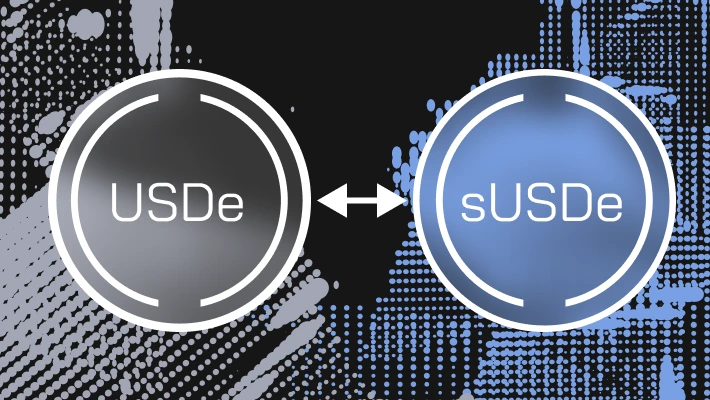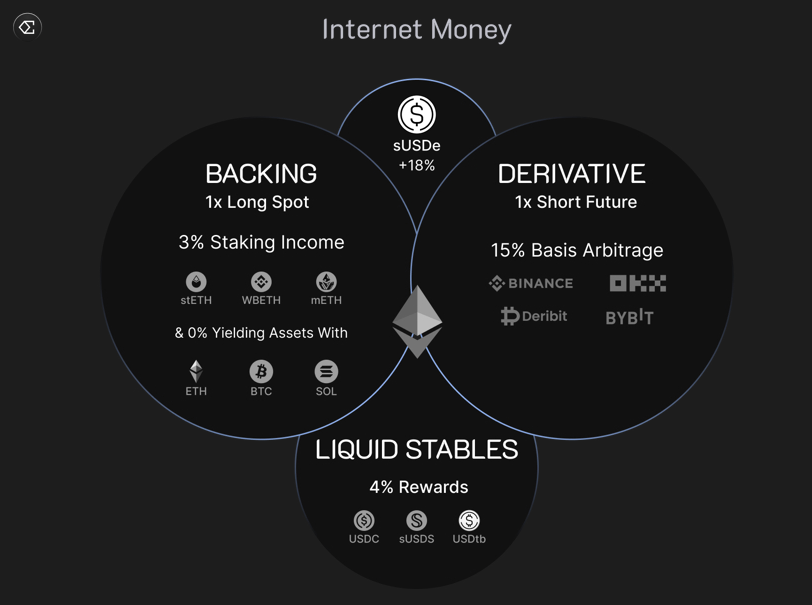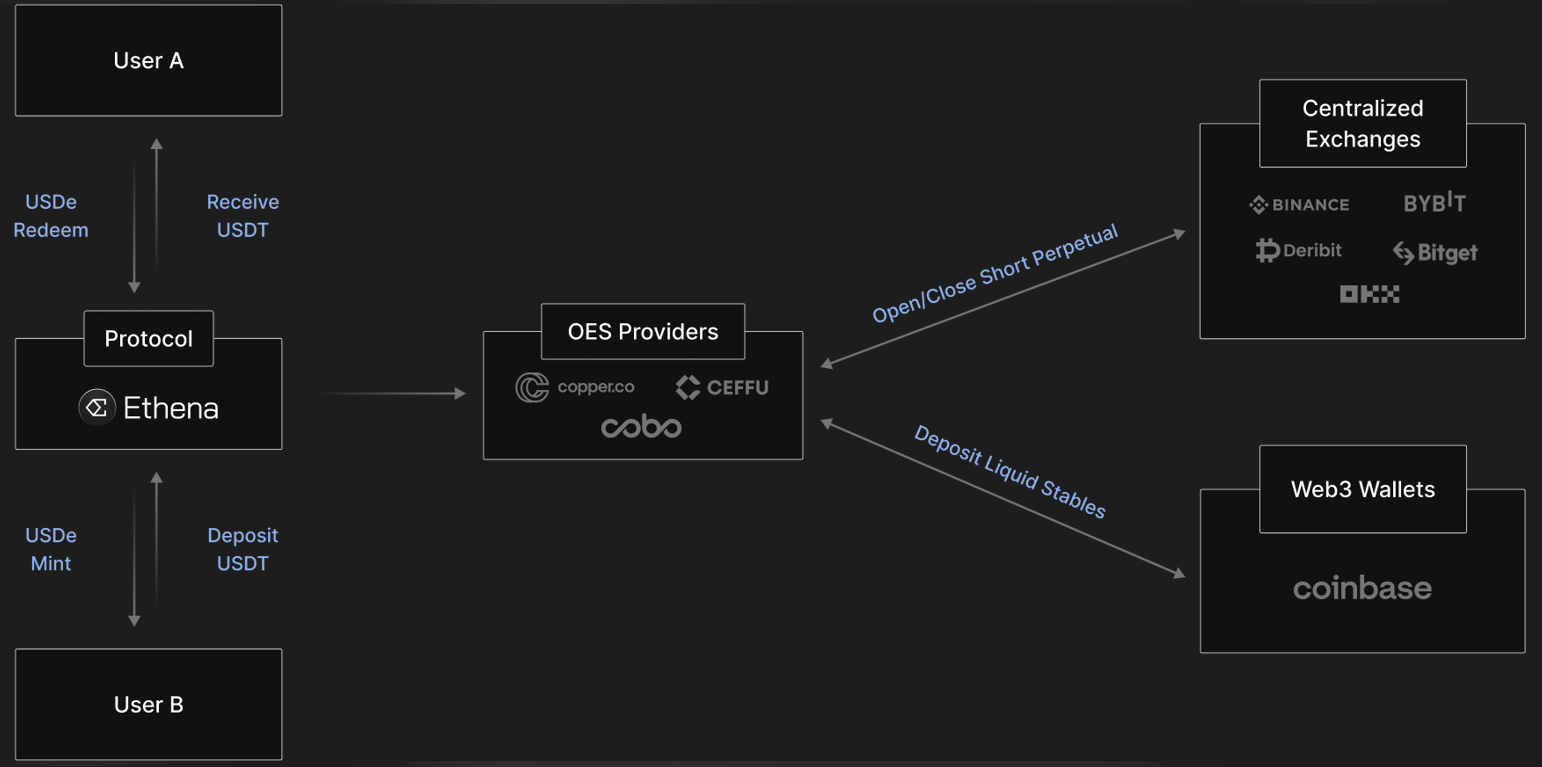Inside Modern Stablecoin Architecture: How Ethena’s USDe Works

If you’re planning to build a stablecoin or researching yield-bearing models, this post is for you.
We’ll break down how Ethena USDe synthetic stablecoin works: Ethena stablecoin delta neutral core, how sUSDe generates and distributes profit, and walk through the technical architecture.
Before we get started, make sure to follow us on X for the latest technical insights
What is Ethena USDe Stablecoin
Ethena USDe is a synthetic dollar stablecoin pegged 1:1 to the U.S. dollar. Simply put, it doesn’t hold funds in a bank like fiat-backed stablecoins. Instead, USDe is fully backed by crypto assets.
The stablecoin value holds steady because of a delta-neutral hedging strategy. The protocol holds long positions in assets deposited as collateral and balances them by equal and opposite short positions in perpetual futures contracts. We’ll dive into all these mechanics later on.
It’s also a yield-bearing stablecoin, meaning Ethena stablecoin lets users generate yield via staking and earn interest from the protocol’s revenue streams.
In short, USDe combines two core features:
- A stablecoin with delta-neutral hedge mechanics
- Yield-bearing design built into the protocol
Now that you have the high-level context, let’s get into the details and see how the system works on a lower level. The first thing to understand is how Ethena keeps USDe pegged to $1.
How Ethena USDe Maintains Stability
At a basic level, every time USDe is minted, the protocol collects an equivalent amount of crypto as collateral. This collateral isn’t just being held, it is actively managed through a delta-neutral strategy. To put it simple, Ethena runs a crypto hedge fund for USDe: long positions in deposited collateral are balanced by equal and opposite short positions on perpetual futures contracts. The combination of the long collateral and the short futures is called a delta-neutral hedge.
This is how it works on example:
- Alice deposits $100 in ETH to mint 100 USDe.
- Ethena opens a $100 short position on ETH perps.
- Price rises 10%: Alice’s collateral grows to $110, short loses ~$10 → net value ≈ $100.
- Price falls 10%: Collateral drops to $90, short gains ~$10 → net value ≈ $100.
The delta-neutral hedge ensures that gains and losses roughly offset, keeping the total backing stable.
Delta-Neutral Mechanics Explained
In Ethena stablecoin delta-neutral positioning relies on maintaining the formula:
Δ = Long Collateral – Short Perpetuals ≈ 0
- The long position is the crypto deposited by users.
- The short position is executed on a perpetual futures market.
- Funding rates from the perpetuals contribute to the yield of staked USDe (sUSDe), we’ll dive into it further in this article
The peg holds during market volatility because Ethena monitors these positions in real time and adjusts short exposure when collateral balances change or funding rates move.
Collateral and Fund Management
The “hedge fund” is fully transparent:
- Collateral is held in custody off-exchange.
- Monthly proof-of-reserves audits verify that every USDe is fully backed.
- The portfolio can include multiple crypto assets, ETH is just one example.
- On-chain and off-chain monitoring ensures short positions are sized correctly relative to total collateral.
Ethena USDe delta neutral hedging limits volatility impact, but has practical constraints: extreme price swings, unexpected funding rate spikes, or liquidity stress on the perp market can still affect the peg.
How Ethena USDe Generates Yield
We’ve already mentioned that USDe is a yield-bearing stablecoin, and it means that the users can earn interest from staking. But before those returns can be paid out, the ethena stablecoin has to generate them.

According to Ethena’s documentation, there are three primary sources of protocol-level yield:
- Futures funding and basis spread earnings
- Staking rewards on collateral
- Fixed returns on liquid stable reserves
The next sections go through how each source generates yield and how the protocol structures and distributes these earnings.
1. Futures Funding and Basis Spread
Futures funding and basis spread are the main drivers of Ethena stablecoin yield. As covered earlier, Ethena maintains delta-neutral positions, holding a crypto asset long while simultaneously opening an equivalent short position on a perpetual futures contract for the same asset. This ensures the protocol earns yield without taking directional market risk.
To understand how yield comes from these positions, it’s worth covering two key concepts: funding rate and basis spread.
How Ethena Generates Yield From Funding Rate
The funding rate is a periodic payment exchanged between long and short positions on perpetual futures to keep the perpetual price aligned with the spot price.
We explained it in detail in our recent take about how modern perpetual DEXes are built, Hyperliquid architecture
The example of how Ethena gets yield from funding:
- Spot BTC: $112,500
- BTC perpetual: $113,000 (slightly above spot)
- Ethena shorts the BTC perpetual while holding $100,000 in BTC.
- Since the futures are at a premium, the long positions pay the short positions periodically (usually every 8 hours).
- Ethena collects these funding payments continuously, generating yield without exposure to BTC’s price movements.
Since crypto market sentiment is bullish more often than bearish, perpetuals on major assets like BTC and ETH often trade at a slight premium. It allows delta-neutral strategies to earn interest-like payments from the market itself. However, it is worth saying that this kind of yield source is fluctuating along with the market, historically it accumulated: ~16% in 2021, ~0% in 2022, ~7–9% in 2023, >12% in 2024.
How Ethena Earns With Basis Spread
The basis spread is the difference between the price of a deliverable futures contract and the spot price of the underlying asset.
How it works:
- If a BTC futures contract expires in 3 months at $115,000 while the spot price is $112,500, there’s a $2,500 positive basis.
- Ethena buys BTC at spot and simultaneously shorts the futures contract.
- When the futures contract settles, the difference between the futures price and spot price is captured as fixed profit, again without taking directional risk.
Basis spread profits are deterministic at the time the position is opened, unlike funding rates, which fluctuate with market sentiment.
2. Staking
In addition to market-based yield from futures, Ethena stablecoin also earns staking rewards on the proof-of-stake assets it holds as collateral. When collateral includes staked ETH derivatives such as stETH, the protocol passively receives about 4% annualized from Ethereum’s native staking yield.
This yield source does not add any new market exposure because stETH remains equivalent to ETH in value terms. The position is still hedged through ETH perpetual futures, which neutralizes price movements. As a result, Ethena stablecoin can keep collecting staking rewards while staying fully delta-neutral.
Staking rewards serve as a secondary revenue stream, adding stability to the protocol’s overall income. They help offset fluctuations in funding rates and create a more consistent earning base for USDe holders. Combined with the funding and basis spread returns, this makes Ethena’s yield more resilient and diversified.
3. Additional Yield on Stablecoin Reserves
According to Ethena docs, 7% of the collateral is held in liquid stablecoins that don’t need hedging: USDC, USDT, and a tokenized T-bill stablecoin called USDtb. And earn yield on them via institutional programs and DeFi. For example, Coinbase pays a loyalty reward on large USDC holdings.
When we've covered the instruments Ethena stablecoin uses to generate yield, it becomes clear that USDe’s APY is neither fixed nor consistent. It depends directly on market conditions, perpetual funding rates, and capital flows in and out of the protocol at any moment.
We got curious about how these early yield strategies actually played out, so we dug into the numbers. At launch, USDe’s APY started around 27%, then spiked past 60% in early 2024 as the first wave of capital entered the protocol. Once liquidity built up and markets stabilized, yields leveled out near 19% APY.
How sUSDe Yield Distribution works in Ethena protocol
Being a yield-bearing stablecoin, Ethena calculates protocol earnings daily. Each week it sets a dollar-denominated APY for sUSDe. Rewards are then paid out to stakers roughly every eight hours across the following week, compounding weekly. A portion may be withheld to a Reserve Fund, buffering periods of negative funding.
How do yield generating stablecoins work
To start accumulating the yield, a user must stake their Ethena USDe stablecoin to get sUSDe, a 1:1 liquid representation of their stake that continues to earn rewards, similar to liquid staking in proof-of-stake networks. To receive the rewards, a user must unstake sUSDe and get back their stake plus any yield that accumulated.
How the Process Yield Distribution in Ethena Works
- Ethena calculates the protocol’s earnings daily and, every week, determines a dollar-denominated APY to distribute to sUSDe holders.
- The payout is done in small payments to sUSDe holders throughout the following week, increasing the redeemable value of each sUSDe.
- This weekly cycle is designed to smooth out volatility and prevent anyone from gaming the system by timing entry/exit around big payouts.
- Ethena doesn’t dump a huge reward all at once; it “drips” the reward continuously over 8-hour intervals. The published APY assumes weekly compounding.
All rewards are distributed via the StakingRewardsDistributor, allowing users to verify earnings on-chain at any time.
We’ve covered how USDe stays pegged and how sUSDe generates yield. Next, we’ll break down the protocol’s architecture, showing how collateral is managed, delta-neutral hedges are executed, and rewards are distributed on-chain.
Technical Architecture Overview
Ethena combines on-chain and off-chain services to manage collateral, maintain the USDe peg, and distribute yield efficiently. The protocol integrated decentralized components for custody and user interaction with centralized exchange infrastructure for liquidity and delta neutral hedging.
Ethena stablecoin core system components:
- Smart contracts on Ethereum for issuance, redemption, and staking.
- Oracle networks for pricing.
- An off-chain hedging engine that interfaces with multiple exchanges and custodians.
Next, we’ll break down each component to show how they work together to keep USDe always pegged and yield-bearing stablecoin.
On-Chain Components
Ethena’s on-chain system consists of multiple Ethereum smart contracts, each handling a distinct part of the protocol. The contracts interact to maintain balances, staking, rewards, and governance, while providing events for off-chain systems to react.
Core Contracts
- USDe Token Contract (ERC-20)
Tracks USDe balances, enforces minting and redemption rules. Minting is restricted to whitelisted addresses; redemptions burn USDe and trigger off-chain hedging updates. Emits Transfer, Mint, and Redeem events. - sUSDe Staking Contract
Locks USDe and issues sUSDe when staking. Burns sUSDe and returns USDe plus yield on unstake. Tracks per-user balances and accumulated rewards. Actions are atomic to prevent mismatches. - ENA Governance Token
Handles governance participation and fee-sharing. Staked ENA does not affect USDe or sUSDe mechanics.
Oracles networks
When building something like a synthetic yield-bearing stablecoin, pricing accuracy is critical. Ethena uses multiple layers of data verification to make sure every mint and redeem reflects real market conditions.
How Ethena ensures data reliability
- Exchange Feeds (Off-chain). This engine streams real-time order book data, trades, and index prices from Binance, Bybit, OKX and other exchanges where Ethena trades. Because Ethena hedges on those exchanges, their prices directly set how much collateral is needed and what each position is worth.
If you want to look deeper into how blockchain data streams work, read our deep dive. - On-Chain Oracles. Ethena pulls data from Pyth and RedStone — price oracles that publish price feeds for BTC, ETH, and other assets on-chain at high frequency, sourced from a mix of CeFi and DeFi markets.
Before any mint or redeem is accepted, the protocol cross-checks prices and ensures that no single source (like one exchange’s API) manipulates the system. If prices differ, the operation stops. - Internal Pricing Engine. Ethena’s off-chain engine calculates the exact amount of USDe to mint or redeem based on deposited collateral, current market prices, and slippage/fee adjustments. It acts as an additional verification layer before interacting with smart contracts.
By combining exchange feeds, on-chain oracles, and the internal pricing engine, it ensures that every mint and redeem of Ethena yield-bearing stablecoin is executed using consistent and reliable price data.
CEX Integration
One of the most technically interesting aspects of Ethena stablecoin is how it links on-chain operations with off-chain centralized exchanges and custodians. The peg mechanism for Ethena USDe stablecoin literally relies on real-time interactions in CeFi markets. This is handled by Ethena’s off-chain hedging system, which bridges smart contracts with live exchange trades.

Off-Exchange Custody (OES)
Ethena uses third-party custodial services to hold the collateral assets and interface with exchanges. The system uses isolated accounts, and the custodian gives the exchange a kind of “you can trade against these funds” signal, so Ethena can open/maintain short positions without handing over the assets. USDe’s short positions can be opened and maintained without transferring full control of the collateral.
Daily, profits and losses (PnL) from exchange positions are reconciled with the custodian. Profitable trades increase the custodian’s balance; losses trigger collateral adjustments to maintain margin. If an exchange fails, the assets remain with the custodian.
Ethena’s exposure is roughly one day of PnL on that venue, not the whole reserve. If an exchange fails, like FTX in 2022, the assets are still at the custodian. Operationally, they stop trading on the failed exchange, reopen hedges elsewhere, and can pause minting or take other protections to keep USDe hedged.
Multi-Exchange Positioning
Positions are split across multiple large exchanges. This way, the protocol distributes counterparty risk, increases liquidity access, and lets the system capture optimal funding rates. The off-chain engine coordinates these spreads, ensuring that on-chain USDe operations remain delta-neutral despite being tied to multiple CeFi venues.
How Ethena USDe Delta-Neutral Hedging Works
Ethena’s delta-neutral system lives off-chain, handling everything from risk monitoring to trade execution. It may sound simple in concept, but in fact, making sure every USDe is backed and hedged in real time is quite complex in execution.
Core Processes in the Hedging System
- Market Data Ingestion: The engine continuously pulls prices, order books, and trades from all connected exchanges and off-exchange custodial accounts.
- Data Validation: Feeds are normalized and cross-checked to prevent inconsistencies or manipulation.
- Portfolio Risk Calculation: Exposure and delta are measured continuously across all positions to ensure the protocol stays balanced.
- Trade Routing & Execution: When users mint or redeem USDe, the system decides which exchanges to use, factoring in liquidity, fees, and funding rates.
- Safety Checks & Alerts: Multilayered checks prevent minting or redeeming if prices are unstable or feeds fail. Alerts notify engineers of any issues.
Simply put, Ethena’s backend operates like a 24/7 high-frequency trading engine combined with a risk management layer. It reacts in seconds to any imbalance, keeping the stablecoin fully backed and delta-neutral.
Risks, Constraints, and Design Trade-Offs
No stablecoin model is flawless, and Ethena USDe comes with its own set of technical and operational risks. According to Ethena documentation, the main risk categories are:
- Reliance on centralized exchanges and custodians
- Dependency on market conditions like liquidity and funding rates
Let’s break them down.
Exchange Failure Risk
If an exchange becomes unavailable or stops processing trades, any positions held there can’t be adjusted. That leaves Ethena temporarily exposed to price changes or unsettled gains/losses.
How Ethena handles it:
- Collateral is kept in a separate custodian, not on the exchange.
- Only unsettled PnL on that exchange is at risk.
- The system can reopen hedges on other exchanges.
- Minting of USDe can be paused during this transition.
- Because positions are spread across multiple venues, losing a single exchange does not break the delta-neutral hedge.
Liquidity Dependence
USDe maintains its peg by opening and closing short positions to hedge collateral volatility. Ethena usde delta neutral hedging only works if derivatives markets have enough liquidity to absorb these trades.
Example:
Ethena needs to hedge $100M of ETH.
- If the ETH perpetual market has $5B in open interest, trades execute with minimal slippage.
- If market liquidity drops to $300M, a $100M position moves the market and increases costs.
Growth is limited by the available liquidity in the short-side markets. BTC and ETH are sufficient; smaller or less liquid assets are not.
Funding Rate Dependence
USDe yield comes from funding payments: longs pay shorts in positive funding periods.
When funding is positive, Ethena’s shorts earn yield. If funding turns negative, shorts pay longs, and yield drops.
Mitigation Mechanisms
To handle funding reversals, Ethena uses:
- Reserve Fund: Saved during positive funding periods to cover losses.
- Diversified Yield: Allocating to stables or T-bills to smooth returns.
- Yield Floor: User APY does not go negative; it is set to zero until conditions improve.
These mechanisms reduce the impact of negative funding but do not remove the dependency on liquid markets.
FAQ
How do yield generating stablecoins work?
Yield-generating stablecoins use their reserves in different institutional programs and DeFi strategies to earn income. Common sources include on-chain lending/borrowing, providing AMM liquidity, and holding tokenized yield assets such as U.S. Treasury bills. Then pass income to holders by raising the token’s redeemable value, rebasing balances, or periodic distributions.
How does Ethena USDe stablecoin work?
USDe is kept stable via delta-neutral hedging. Collateral, for example, ETH/BTC/stables, is held in off-exchange custody while Ethena opens short perps on multiple CEXs, targeting Δ ≈ 0. Whitelisted market makers mint/redeem at $1, and arbitrage closes any price gaps. A 24/7 delta-neutral hedging engine manages risk.
What is Ethena USDe delta neutral stablecoin?
A delta-neutral stablecoin balances long collateral and short derivatives so net price exposure is close/equal to zero. Gains on one side offset losses on the other, keeping the USD value stable: Δ = Long – Short = 0.
How does Ethena generate yield?
Yield is generated by holding short positions that receive payments from long positions via funding, futures basis, and staking rewards on PoS collateral, plus some yield on stable reserves.
What is the difference between USDe and sUSDe?
USDe is the synthetic stablecoin. sUSDe is the staked, yield-bearing version: stake USDe 1:1 to receive sUSDe, which accrues the protocol’s weekly yield. Unstaking returns USDe plus accrued rewards.
Is Ethena USDe algorithmic or synthetic?
Ethena USDe is synthetic. It’s fully collateralized and delta-hedged using derivatives; stability comes from hedges and arbitrage. The design is a CeDeFi hybrid: on-chain issuance with off-exchange custody and multi-exchange hedging.
About Rock’N’Block
Rock’n’Block is a Web3-native development studio building production-grade blockchain infrastructure and decentralized applications. We help founders launch high-performance products faster, build UX that can serve millions of users, and stand out in competitive markets.
Follow us on X for more deep dives.
What We Do
- Build custom Layer-1 chains, DeFi protocols, and decentralized exchanges.
- Develop perpetual DEXes with order books, funding rates, margining, liquidations, and oracle integrations.
- Create blockchain data streaming solutions that process real-time and historical data efficiently.
- Implement chain-agnostic payment solutions and financial tooling.
Our team has nearly 10 years of hands-on blockchain experience, supporting products used by 71M+ DeFi users, across systems totaling $2.5B in market cap, and helping partners raise $167M.
We ♥️ Development




%20MetaDEXes%20work%20thumbnail.webp)







%201.webp)



